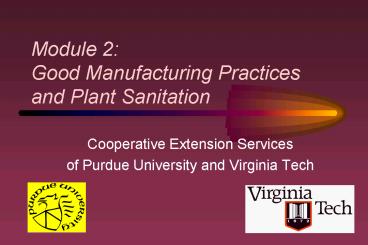Module 2: Good Manufacturing Practices and Plant Sanitation - PowerPoint PPT Presentation
1 / 24
Title:
Module 2: Good Manufacturing Practices and Plant Sanitation
Description:
Cleaning and sanitation programs are keys to successful GMPs and SSOPs. Cleaning ... Different sanitizers will be used for different food products. ... – PowerPoint PPT presentation
Number of Views:390
Avg rating:3.0/5.0
Title: Module 2: Good Manufacturing Practices and Plant Sanitation
1
Module 2 Good Manufacturing Practices and Plant
Sanitation
- Cooperative Extension Services
- of Purdue University and Virginia Tech
2
Good Manufacturing Practices
- GMPs are minimum sanitary and processing
requirements necessary to ensure the production
of wholesome food. - Prescribed requirements for
- personnel
- building and facilities
- equipment and utensils
- production and process controls
3
GMPs Personnel
- Knowing how and when to wash hands
- Understanding the importance of clean uniforms
- Proper use of hair and beard nets
- Policy on jewelry
- Policy on chewing tobacco, smoking, and eating
4
GMPs Building and Facilities
- Handwashing stations
- Storage of ingredients (refrigerated
and on pallets) - Separation of raw ingredients from processed
foods - Pest management program
5
GMPs Equipment and Utensils
- Easily cleaned and sanitized
- Easily maintained
- Meet food grade standards
6
GMPs Production and Process Controls
- Time/temperature control charts
- Records on food ingredients
- Lot identification and coding
- Product weight controls
7
Good Manufacturing Practices
Examples Of GMPs
8
Why is this Important?
9
Why is this Important?
10
Whats Wrong with this Picture?
11
Whats Wrong with this Picture?
12
Whats Wrong with this Picture?
13
Standard Operating Procedures
- Standard Operating Procedures (SOPs) are
established or prescribed methods to be followed
routinely for the performance of designated
operations or in designated situations.
14
Standard Operating Procedures
- SOPs relate to specific tasks and should address
the following - the purpose and frequency of doing a task
- who will do the task
- a description of the procedure to be performed
that includes all the steps involved - the corrective actions to be taken if the task is
performed incorrectly
15
Standard Operating Procedures
Examples Of SOPs
16
Sanitation SOPs
- Sanitation Standard Operating Procedures (SSOPs)
are prescribed methods specifically for cleaning
and sanitizing.
17
Sanitation SOPs
Examples Of Sanitation SOPs
18
Cleaning and Sanitizing
- Cleaning and sanitation programs are keys to
successful GMPs and SSOPs.
19
Cleaning
- Cleaning is the chemical or physical process of
removing dirt or soil from surfaces. - Cleaning removes 90-99 of the bacteria, but
thousands of bacteria may still be present.
20
Sanitizing
- Sanitizing is the process that results in
reduction/destruction of microbes. - Different sanitizers will be used for different
food products. Chlorine, iodophors, and
quaternary ammonia compounds are the most common
sanitizers used.
21
Sanitation Programs
- Buildings and grounds
- Raw material handling and storage
- Processing hygiene and handling finished goods
- Pest control
- Waste disposal
- Employee hygiene and facilities
- Finished product storage
- Transportation
22
Why is this Important?
23
Why is this Important?
24
Why is this Important?

